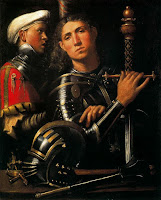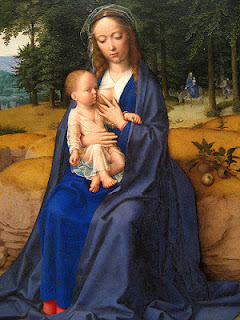In my interpretation of Giorgione's Tempest as the “Rest on the Flight into Egypt,” I argued that the nudity of the Woman was Giorgione’s attempt to portray Mary as the Immaculate Conception. Although theologians had debated the dogma for centuries, it was only its resurgence in the fifteenth century that led artists to finally attempt to treat the subject.
Emile Male: Religious Art in France, The Thirteenth Century, Princeton, 1986. Pp. 234-240. This volume has been printed in paperback as “The Gothic Image.”
 The cult of the Virgin that grew up in the twelfth century spread during the thirteenth. The bells of Christendom began to ring the Angelus. The Office of the Virgin was recited daily. Our most beautiful cathedrals were dedicated to her. The idea of the Immaculate Conception began to take form in the minds of Christians who for centuries had meditated on the mystery of a Virgin chosen by God. … New religious orders—the Franciscans and the Dominicans—were true knights of the Virgin and spread her cult among the people…. (234-5)
The cult of the Virgin that grew up in the twelfth century spread during the thirteenth. The bells of Christendom began to ring the Angelus. The Office of the Virgin was recited daily. Our most beautiful cathedrals were dedicated to her. The idea of the Immaculate Conception began to take form in the minds of Christians who for centuries had meditated on the mystery of a Virgin chosen by God. … New religious orders—the Franciscans and the Dominicans—were true knights of the Virgin and spread her cult among the people…. (234-5)In all the books written to glorify the Virgin, perhaps the idea that recurs most often is that Mary is Queen…. (235)
Among the many ideas and feelings that clustered around the Virgin in this period, the idea of royalty was the one best understood and most strongly expressed by artists. The Virgin of the twelfth and early thirteenth centuries is a queen… Mary is a queen who holds the King of the world. At no other period were artists able to confer such majesty upon the image of the mother of God. (235-6)
Toward the end of the thirteenth century, the Virgin of the theologians, as majestic as pure idea, seemed too remote from man. All the miracles attributed to her in the thirteenth century, all the times she appeared to sinners, merciful and smiling, had brought her closer to mankind. It was then that the artists, faithfully interpreting the feelings of the people, conceived the Virgin of the north portal of Notre-dame of Paris as a mother radiating maternal pride…the virgin had grown to womanhood; she is a mother. (239)
In the fourteenth century, the Virgin and Child group, represented with such solemnity a century before, has only intimacy left. The theological ideas represented by the Virgin, became less and less accessible to artists. They did not comprehend…’that it was the desire of the Infinite God to unite with a Virgin’… they could no longer recreate the superhuman Virgins of the past. They were satisfied to represent a mother smiling at her child.
Soon they would bring the Virgin even closer to humanity through her grief. But the Mater Dolorosa that inspired so many masterpieces in fifteenth-century art, the Virgin old before her time who wept over the bleeding forehead of her son, does not belong to the century under study. [13th]…artists did not yet dare to express her grief….
If the artists liberated themselves fairly early from the ideas of theologians, they remained on the contrary faithful to the legends. They borrowed almost all the episodes in the life of Mary from the apocryphal Gospels….
It did not occur to thirteenth-century artists, as it would to those of the late Middle Ages, to represent the Virgin before her birth. The thirteenth century left this to the sixteenth. It was shortly after 1500 that the young girl with long hair, surrounded by the rose, the star, the mirror, the fountain, and the closed garden appeared in stained glass windows, tapestries, and Books of Hours. This Virgin—a pure concept, anterior to time, an eternal thought of god—did not yet exist. Such a lofty idea, and one imminently suited to serve as inspiration to artists contemporary with St. Bonaventura and Dante, was however unknown to them…. (239-240)
Neither did thirteenth-century artists go back to the father and mother of St. Anne in the genealogy of the virgin…. the artists dealt only with the story of St. Anne and St. Joachim, her first husband….
The meeting at the Golden Gate is the subject most frequently depicted. The artists of the late Middle Ages had a marked predilection for it. In fact, it was the only way that had been devised to represent the Immaculate Conception. Although the error had been condemned by the Church Doctors, it was repeated that Mary had been conceived at the moment when Anna and Joachim kissed.
The following excerpts are from the third volume in the series,
Religious Art in France, the later Middle Ages, Princeton, 1986.
toward the end of the fifteenth century, a mysterious idea that had been secretly germinating in man’s soul for more than five hundred years, suddenly blossomed. It now seemed clear to theologians that the Virgin could not have partaken of original sin, being especially exempted from the law by divine decree. Mary, the perfect model of newly created humanity, like Eve at the time she was created by the hands of God, had come into the world free of the burden of sin. (197)
The dogma of the Immaculate Conception was an ancient idea that already had its followers in England and Normandy as early as the eleventh century. (197)
This doctrine, supported by the Synod of Basel in 1439, approved by Pope Sixtus IV in 1476, and accepted as dogma by the Sorbonne in 1496, would inevitably have found its expression in art…. (198)
The task was difficult. How was one to represent the Virgin as a pure concept? How convey her creation without sin, by God’s decree, her existence in his thought before the creation of time? (199)
From the fifteenth century on, artists tried to resolve the problem. They first thought of the woman spoken of so mysteriously in the Apocalypse. She has the moon beneath her feet, stars on her head, and the sun envelops her; she seems older than time, no doubt conceived before the universe….
In the fifteenth century, in fact, we find manuscripts containing a half-length figure of the Virgin, who seems to rise out of a crescent moon and to shine like the sun….there can be no doubt that the Virgin of the crescent moon was the first symbolic representation of the Immaculate Conception
 In the early years of the sixteenth century, a most poetic figure of the Virgin appeared in France. She is a young girl, almost a child; her long hair covers her shoulders…The young virgin seems to be suspended between heaven and earth. She floats like an unexpressed thought, for she is only an idea in the divine mind. God appears above her, and seeing her so pure, pronounces the words of the song of songs: Tota pulchra es, amica mea, et macula non est in te (Thou art all fair, O my love, and there is not a spot in the). And to express the beauty and purity of the betrothed chosen by God, the artist chose the most pleasing metaphors of the Bible: around her he placed the closed garden, the tower of David, the fountain, the lily of the valleys, the star, the rose, the spotless mirror. (200)
In the early years of the sixteenth century, a most poetic figure of the Virgin appeared in France. She is a young girl, almost a child; her long hair covers her shoulders…The young virgin seems to be suspended between heaven and earth. She floats like an unexpressed thought, for she is only an idea in the divine mind. God appears above her, and seeing her so pure, pronounces the words of the song of songs: Tota pulchra es, amica mea, et macula non est in te (Thou art all fair, O my love, and there is not a spot in the). And to express the beauty and purity of the betrothed chosen by God, the artist chose the most pleasing metaphors of the Bible: around her he placed the closed garden, the tower of David, the fountain, the lily of the valleys, the star, the rose, the spotless mirror. (200)Such an image no doubt answered the innermost feelings of Christians, for it was soon repeated ad infinitum…. (202)
Images of the Immaculate Conception usually appeared alone. Their numbers increased due to the confraternities of the Virgin which celebrated her Conception,… (204)
Thus, the Tree of Jesse was considered a sort of symbol of the Immaculate Conception…. the true reason for the presence of the Tree of Jesse in so many churches lies, I believe, in the cult of the Virgin, and, especially, in the cult of her Conception. (205)
Thus the era of the Middle Ages ended. For more than a thousand years it had worked to fashion the image of the Virgin; this was its ever-abiding thought, its secret and profound poetry. And it might be said that the Middle Ages came to an end at the exact moment when it had made this cherished image as perfect as its dream. (209)
Of course, Male’s work centered around France and its cathedrals but the cult of the Immaculate Conception was certainly not limited to France. In Piety and Patronage in Renaissance Venice, Rona Goffen demonstrated that Venice itself became identified with the Immaculate Conception by the end of the Quattrocento.
Note: Below is an image of the Immaculate Conception as the Woman from the Book of Revelation (Apocalypse) in a stained glass window of Our Lady of the Assumption church in Fairfield, Connecticut. The church was built in 1939 and Mary has an "art deco" look. Notice that her dress is not the traditional red, a sign of her humanity, but white, a symbol not only of her purity but also of her conception in the mind of God. The putti and the colored arcs behind her are traditional symbols indicating a heavenly scene.
















.jpg)











